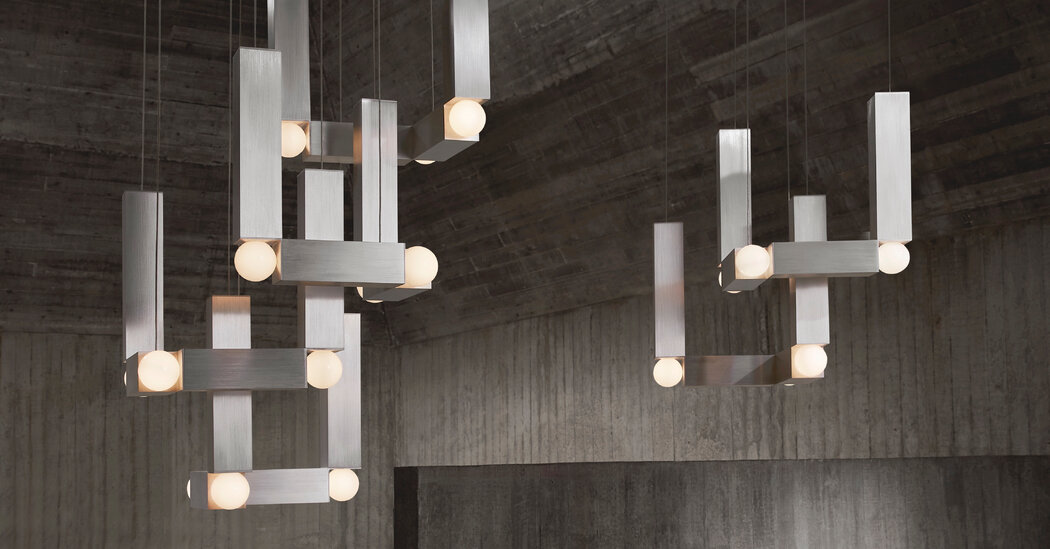
This article is part of our Design special report previewing 2022 Milan Design Week.
Combining features of Brutalist architecture with the transcendent experience of houses of worship, Divine Inspiration is a series of six new lighting collections by the British product and interior designer Lee Broom. On view through June 12 at Blindarte, a gallery in the Brera neighborhood in Milan, the designs are Mr. Broom’s first in four years and mark his namesake company’s 15-year anniversary.
Mr. Broom, 46, grew up in Birmingham, England, in the West Midlands, a place that, he said in a recent video call, “has a reputation for not being the most attractive city in the U.K.”
Much of Birmingham was demolished in World War II bombing raids and then rebuilt. It is known for its raw, monolithic Brutalist buildings, a sort of concrete city. “I remember my parents and grandparents loathed this kind of architecture,” Mr. Broom said. “It was considered incredibly ugly.”
Mr. Broom, however, had a different perspective — he thought it was incredibly beautiful. “I just loved the geometry and the materials,” he said.
One of his favorite structures was the Birmingham Central Library, which opened in 1974. He visited often as a child. “There were these beautiful corner reading areas sort of interjected into the pillars and into the fabric of the building, with walnut shelving combined into this Brutalist architecture,” he said. The building, which was designed by John Madin, an acclaimed local architect, was demolished in 2016, which Mr. Broom called “a real travesty.”
He said he was inspired not only by Brutalism’s forms and materials, but also by the way the structures pair minimalism with drama, a feeling often created through the use of light — the effect, he said, that he wanted to capture in his new pieces. But Mr. Broom did not want simply to mimic the models he grew up with. He took the silhouettes and geometries and transformed them, dressing rectangular and spherical shapes in rough-hewn finishes.
His new Vesper collection, for example, is a play of basic forms in anodized brushed silver or brushed gold, suspended by cables. Although these lights are all angles, they have an appearance of softness and weightlessness. The Altar and Hail collections combine solid oak or brushed metal with light tubes that hang in long pendants in a variety of configurations. Chant, a flat chandelier of glass brick, recalls the popularity of glass blocks in 1970s houses of worship, when they were frequently used in lieu of stained glass.
Mr. Broom’s recognition of the way Brutalism lends itself to spirituality began with his appreciation, around age 14, of the reconstructed Coventry Cathedral, which stands just outside Birmingham. It struck him as chic, sophisticated and moving. “I don’t think you have to be religious to be touched or inspired when you walk into a place of worship,” he said.
The idea for another collection, called Pantheum, came from the Pantheon in Rome. The coffered concrete dome of the pagan-temple-turned-Catholic-church reminded him of the ceilings found in certain parking garages built in the 1970s. He started producing this collection in concrete, but he found the material difficult to work with and wanted something more sustainable. He eventually settled on Jesmonite, a mixture of gypsum and resin invented in 1984 whose production generates less carbon dioxide than concrete’s. It allows him to have both the precise geometry and rough texture he desires.
The Requiem collection is based on Brutalist sculpture but also inspired by drapery carved in stone statuary around tombs and crypts. Mr. Broom used the anniversary as a way to return to getting his hands dirty by doing the fabrication himself. “As the company grows and as the kind of machine around you starts to get bigger and bigger, in a way what you do sort of becomes smaller,” he said.
He begins with a long piece of cotton-blend fabric dipped in plaster of Paris. Using a metal form for support, he drapes the treated fabric, sometimes pulling it through ring lights or nestling a ball light inside a sling. The plaster begins to set immediately, giving him only about 10 minutes to complete the form. After some cutting and finessing, he smooths out any imperfections.
The process is a return to Mr. Broom’s fashion days. Early in his career, he did pattern cutting and draping for Vivienne Westwood and later earned a degree in fashion from Central Saint Martins in London. (He originally used the dipped-fabric technique to make mirrors he sold at the Portobello Road street market, which he said were not a big success.)
Mr. Broom chose to show the new lights at Milan Design Week in the manner of an art exhibition. “I like the idea of taking the viewer on a journey, so each of the collections has its own room, its own specific area,” he said. He also wanted to summon the emotional impact of a place of worship.
“In whatever form they are constructed,” he said, “the idea — going back even to antiquity — was that you were trying to bring the viewer closer to God.”






